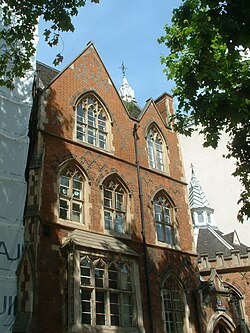History
Philological School
Founded as the Philological Society by Thomas Collingwood, under the patronage of the Prince Frederick, Duke of York and Albany, its object was to help "the heads of families, who by unexpected misfortune, have been reduced from a station of comfort and respectability." Founded in Mary Street (later renamed Stanhope Street), NW1, it moved to Marylebone Road in 1827. Its fortunes improved largely due to Edwin Abbott, headmaster from 1827 to 1872. After Abbott, the school's financial position deteriorated. [1]
Grammar school
In 1901 it was accepted in trust by the London County Council and renamed St Marylebone Grammar School. After World War II it recovered. Under headmaster Philip Wayne it developed artistic activities, acquired shared use of playing fields in Sudbury Hill, and established a country base in the village of Forest Green, near Leith Hill. [2] In 1957 the motto "ex animo tamquam Deo" ("from the heart, as from God") was added to the school's crest at the suggestion of the deputy headmaster Kenneth Crook. [1] [3]
After Philip Wayne, SMGS was led by Harry Llewellyn-Smith as headmaster until 1970. During his period a new and separate science block was built a short walk away from the school's main site. Roy Mansell led the science team and was for a short period, following Patrick Hutton's tenure, the final headmaster. [1]
Closure
Soon after headmaster Patrick Hutton (formerly head of English [4] at St Paul's School) arrived in 1970, the Inner London Education Authority (ILEA) proposed to merge SMGS with the local secondary modern school, Rutherford School, later part of North Westminster School. ILEA itself came into conflict with the new Conservative government, whose secretary of state for education Margaret Thatcher took an interest in SMGS. By 1981, however, SMGS had closed. [5]
This page is based on this
Wikipedia article Text is available under the
CC BY-SA 4.0 license; additional terms may apply.
Images, videos and audio are available under their respective licenses.



